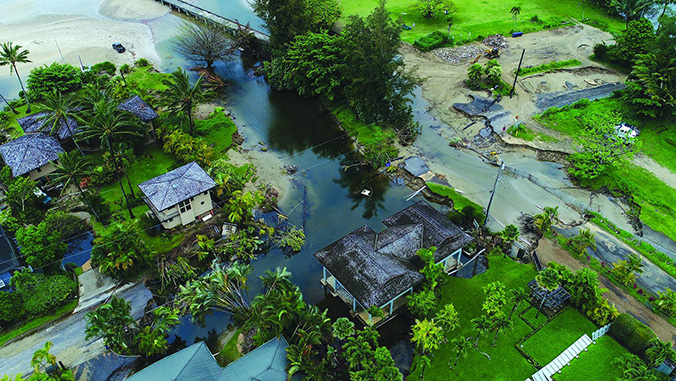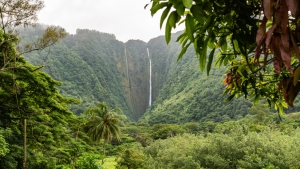
The University of Hawaiʻi at Mānoa is part of a consortium of 28 institutions awarded $360 million by the National Oceanic and Atmospheric Administration (NOAA) over the next five years to improve the nation’s ability to predict water-related hazards, such as flooding, and effectively manage water resources.
The effort establishes the Cooperative Institute for Research to Operations in Hydrology (CIROH) that consists of a consortium of 22 institutions of higher education along with non-profit organizations and government and industry partners, and creates a team of hydrologic researchers across the U.S and Canada. The mission is to help realize NOAA’s vision of a water-and-weather-ready nation by developing and delivering national hydrological analyses, forecast information, data, guidance and support services to inform essential emergency management and water resources decisions.
The UH Mānoa Water Resources Research Center (WRRC) will coordinate the UH effort. The new NOAA cooperative institute will focus much of its work on the National Water Model (NWM), which provides vital information for purposes such as for flood forecasting.
“Currently, the skill of the Hawaiʻi implementation of the NWM is generally not sufficient to provide useful information to the National Weather Service to support their forecasting and extreme event warning responsibilities,” said WRRC Director Thomas Giambelluca, the project lead for UH. “In this project, the CIROH–Hawaiʻi team will conduct research to improve the Hawaiʻi-specific and more general performance of the current and future versions of the NWM. UH Mānoa brings a wealth of expertise to the consortium regarding tropical weather and hydrological processes, especially for the Hawaiʻi region.”
UH water projects

The first round of UH projects to be supported under CIROH will be:
- Making the Hawaiʻi Climate Data Portal a resource for the National Water Model
- Evaluating the National Water Model in Hawaiʻi
- Improving streamflow predictions via ensemble assimilation of streamflow data into the National Water Model
- A library of Hawaiʻi storm case studies
- Probability of precipitation
- Inundation modeling for Hawaiʻi
- Drought in Hawaiʻi
- Visualizing vulnerability to extreme weather
CIROH will also provide support to bolster UH’s water-related course offerings and graduate studies opportunities.
“In a time where climate change and other human-related actions are severely impacting water resources and weather around the world, hydrological research has become paramount to creating sustainable and resilient management solutions,” said UH Vice President for Research and Innovation Vassilis L. Syrmos. “The University of Hawaiʻi is pleased to be part of this important NOAA consortium and is well-represented by UH Mānoa’s Water Resources Research Center and its cadre of multidisciplinary experts in weather- and water-related research.”
More about CIROH
CIROH will advance water research in support of NOAA’s Office of Water Prediction and reinforce the work of the National Weather Service and National Water Center through collaboration across the scientific community in four broad research themes:
- Water resources prediction capabilities
- Community water resources modeling
- Hydroinformatics
- Application of social, economic and behavioral science to water resources prediction
CIROH will create curriculum programs across its consortium members and partners to prepare the next generation of water professionals. Local-to-national scale workforce training programs will translate CIROH advances into practice. Extensive outreach and engagement will connect CIROH to stakeholders helping communities build resilience to water-related risks. The consortium is led by the University of Alabama and based out of the Alabama Water Institute.
CIROH’s 14 consortium members include: University of Hawaiʻi at Mānoa; The University of Alabama; Brigham Young University; Colorado School of Mines; Tuskegee University; The University of Alabama in Huntsville; University of Arizona; University of California San Diego, Scripps Institution of Oceanography; University of Iowa; University of Minnesota, Twin Cities; University of Saskatchewan; University of Utah; University of Vermont; and Utah State University.
Consortium partners include: Baron Weather Inc.; Coastal Carolina University; Consortium of Universities for the Advancement of Hydrological Science Inc.; Dauphin Island Sea Lab; Gulf of Mexico Coastal Ocean Observing System; Jupiter Intelligence; New Mexico State University; Oak Ridge National Laboratory; The Pennsylvania State University; RTI International; Stevens Institute of Technology; University of California, Davis; University of Illinois at Urbana-Champaign; and University of South Carolina.
This work is an example of UH Mānoa’s goal of Excellence in Research: Advancing the Research and Creative Work Enterprise (PDF), one of four goals identified in the 2015–25 Strategic Plan (PDF), updated in December 2020.

